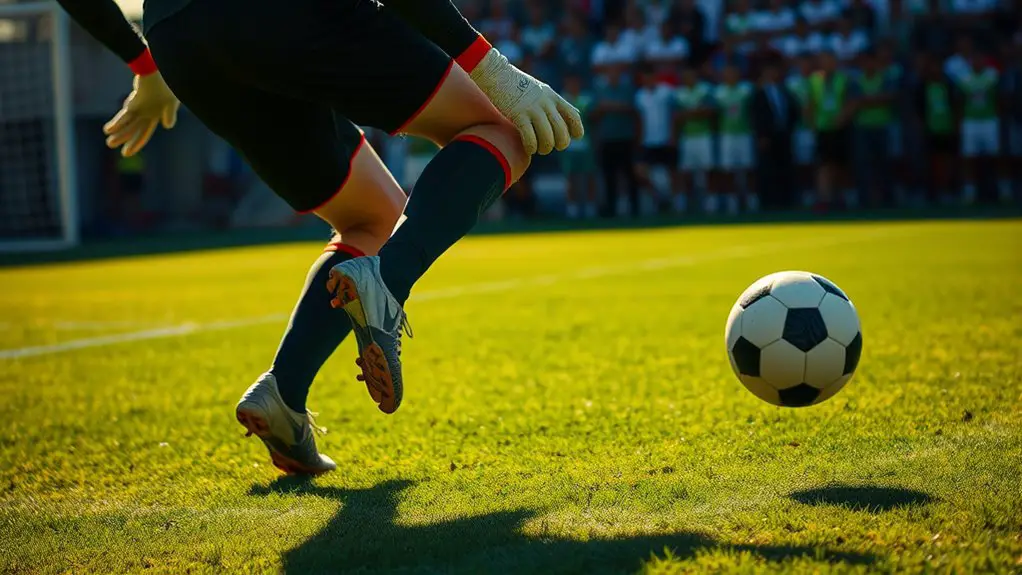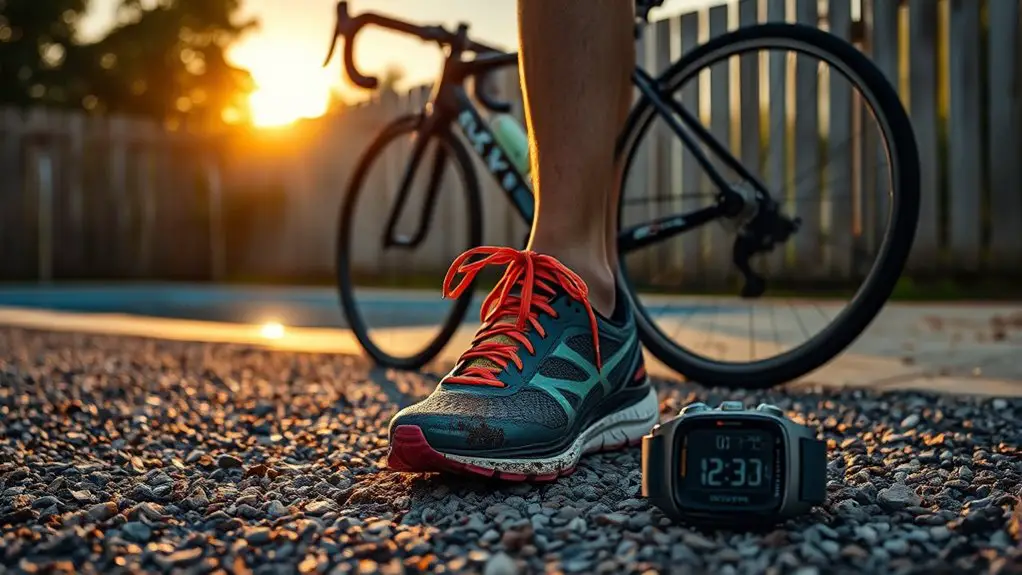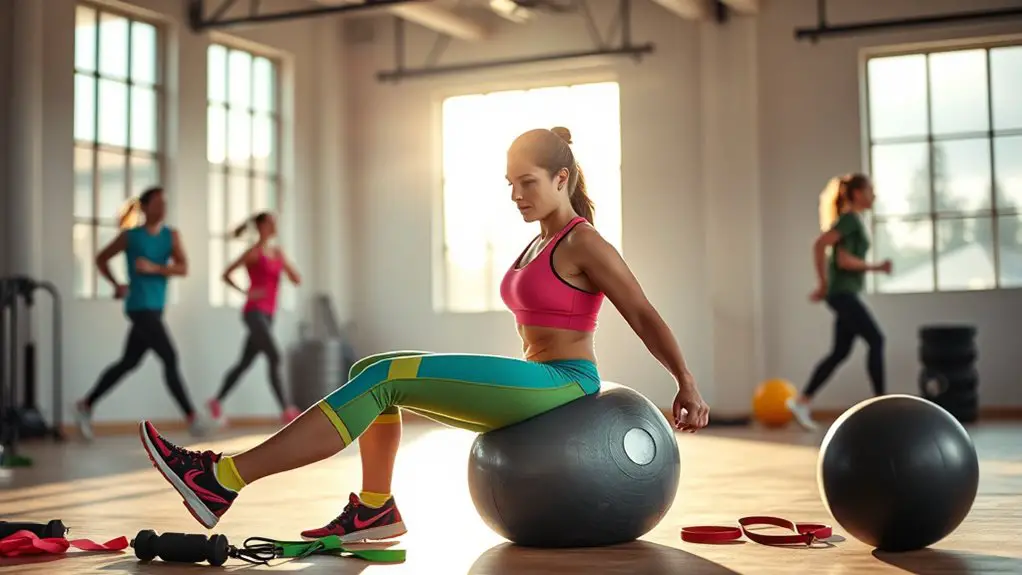To develop a quick release as a goalkeeper, focus on refining your ball handling and decision-making skills. Maintain a relaxed grip while aligning your body towards the target for accurate passes. Practice agility drills to improve your footwork and reaction time. Situational awareness is essential, so always scan the field for options. Incorporating mindfulness helps reduce anxiety in pressure moments. Keep pushing yourself, and you'll discover more techniques to enhance your quick release.
Understanding the Importance of a Quick Release
When you think about a goalkeeper's role, you might not immediately consider the significance of a quick release, but it can make all the difference in a match. A swift release can turn the tide, launching your team on the offensive before the opposition can regroup. Proper goalkeeper positioning allows you to anticipate plays and react instinctively. You've got to be ready to handle the ball efficiently, whether it's a catch or a deflection.
This agility in ball handling isn't just about speed; it's about making those split-second decisions that keep your team in the game. The quicker you can distribute the ball—be it with a throw or a kick—the more freedom your teammates have to exploit defensive gaps. Embracing this aspect of your role empowers you to take control, fostering a dynamic flow of play that can lead to exhilarating scoring opportunities. Incorporating agility training techniques into your practice routine can further enhance your quick release skills.
Key Techniques for a Fast Ball Release
A quick release isn't just about speed; it requires mastering specific techniques that enhance your efficiency in distributing the ball. Focus on your ball handling and make sure your grip is solid yet relaxed. This balance allows for better control and quicker reaction. Use your body to support your passing techniques; pivot your hips and shoulders to generate more power and accuracy. Incorporating mental conditioning techniques can further improve your ability to react and distribute the ball effectively under pressure.
Here's a simple table to help you remember key techniques:
| Technique | Description |
|---|---|
| Grip | Maintain a relaxed yet firm hold on the ball. |
| Footwork | Position your feet for ideal balance. |
| Body Alignment | Align your body with your target before passing. |
| Follow Through | Complete your motion to enhance accuracy. |
| Vision | Scan the field to quickly identify passing options. |
These elements will free you to distribute the ball with confidence and speed.
Drills to Improve Reaction Time
When it comes to improving your reaction time, quick reflex exercises are essential. You'll want to incorporate specific reaction time drills that challenge your ability to respond quickly under pressure. By focusing on goalkeeper response training, you can sharpen your instincts and enhance your overall performance. Additionally, mental training techniques such as visualization can help prepare your brain for rapid responses in crucial game situations.
Quick Reflex Exercises
To enhance your reaction time as a goalkeeper, incorporating quick reflex exercises into your training routine is essential. These exercises not only sharpen your reflexes but also boost your overall agility on the field. Start with simple reflex training drills, like catching rebounds from a wall or practicing with a partner who randomly tosses balls your way. Incorporate agility drills, such as ladder drills or cone sprints, to develop your foot speed and coordination. The key is to keep your body and mind engaged, making quick decisions under pressure. Remember, the more you practice these exercises, the more instinctive your reactions will become during games. Embrace the challenge, and watch your performance soar!
Reaction Time Drills
Improving your reaction time as a goalkeeper is essential for making split-second saves and decisions during a match. To enhance your skills, incorporate various reaction drills into your training routine. One effective drill involves having a partner randomly throw balls at different angles, forcing you to respond quickly. You can also use a reaction ball; its unpredictable bounce will sharpen your reflexes. Timing exercises, like sprinting to a designated spot upon hearing a whistle, can further develop your speed and responsiveness. Remember, the key is consistency—practice these drills regularly. Embrace the freedom to experiment with different techniques, and soon you'll notice a significant improvement in your reaction time, helping you dominate the goal.
Goalkeeper Response Training
Building on your reaction time drills, goalkeeper response training focuses on honing your ability to anticipate and react to various game situations. To develop your goalkeeper agility, incorporate drills that simulate real match scenarios. For instance, set up cones and practice lateral movements while reacting to a coach's commands that mimic shots. This helps improve shot anticipation as you learn to read the striker's body language and shot trajectory. Another effective drill is the "rapid-fire" exercise, where you face multiple shots in quick succession, forcing you to rely on reflexes and decision-making. By consistently practicing these techniques, you'll elevate your game, allowing you to become a more dynamic and responsive goalkeeper, ready to seize every opportunity that comes your way.
Practicing Proper Footwork
Mastering proper footwork is essential for goalkeepers looking to execute a quick release effectively. You've got to focus on your foot placement to guarantee you're always in the right position to make that swift pass or clearance. Start with a solid foundation—your feet should be shoulder-width apart, allowing for quick lateral movement in any direction.
To enhance your agility, practice drills that involve quick shuffles and side steps. As you move, keep your knees slightly bent and your center of gravity low so you can pivot and react instantly. Visualize the ball and anticipate where it'll come from; this helps you move fluidly rather than just reactively. Remember, the quicker you get into the right position, the faster you can release the ball. Embrace the freedom of movement, and soon enough, you'll be a master at executing that quick release! Incorporating agility ladder drills into your training can significantly boost your foot speed and coordination, further aiding in your quick release.
Decision-Making Under Pressure
Once you've honed your footwork, the next step is sharpening your decision-making under pressure. It's essential to develop situational awareness, so you can read the game and anticipate plays. In high-stress moments, you might face decision fatigue, where too many choices cloud your judgment. To combat this, practice recognizing patterns during drills, which helps streamline your thought process during a match.
Engage in small-sided games or scenarios that simulate pressure situations. This will force you to make quick decisions, enhancing both your confidence and instincts. Remember, the quicker you can assess your options—whether to distribute the ball short or go long—the more effective your quick release becomes. Trust your training, stay calm, and let your body respond. By focusing on these aspects, you'll free your mind to react naturally, keeping the game flowing and your teammates in play. Incorporating mindfulness practices can also help you stay present and reduce anxiety during critical moments.
Incorporating Quick Release Into Game Situations
Incorporating a quick release into game situations can greatly enhance your effectiveness as a goalkeeper. By developing situational awareness, you can better anticipate plays and respond swiftly. Here are a few game scenarios to practice your quick release:
| Game Scenario | Quick Release Technique |
|---|---|
| Counterattack Defense | Distribute the ball quickly to a wing player |
| Goal Kick Situations | Use a low drive pass to a defender |
| After a Save | Roll the ball to initiate a fast break |
| Corner Kick Defense | Quickly clear the ball to a safe area |
Each of these situations demands a quick decision and execution. Embrace the freedom to adapt your release technique based on what you see on the field. The more you practice, the more instinctive it'll become, allowing you to stay ahead of the game.
Monitoring Progress and Continuous Improvement
As you integrate quick release techniques into your game, it's essential to monitor your progress and seek continuous improvement. Start by establishing goal tracking methods that fit your style. Set specific, measurable objectives for your quick release, whether it's reducing the time it takes to release the ball or improving accuracy.
After each practice, create feedback loops. Analyze your performance, noting what worked and what didn't. Don't hesitate to ask coaches or teammates for their insights; their perspectives can offer valuable lessons.
Record your findings to recognize patterns and trends over time. Adjust your training accordingly, focusing on areas that need development. Incorporating mindfulness in athletic performance can also significantly enhance your ability to maintain focus during practice and games.
Frequently Asked Questions
How Can Goalkeepers Improve Their Overall Confidence During a Quick Release?
To boost your overall confidence during a quick release, focus on mental visualization. Picture yourself executing the release perfectly, imagining the ball flying where it needs to go. This mental practice can make a world of difference. Combine that with consistent practice, allowing your body to develop muscle memory. The more you train, the more freedom you'll feel during matches. Embrace the process, and you'll find your confidence soaring when it counts!
What Equipment Can Enhance a Goalkeeper's Quick Release Practice?
"Practice makes perfect," and when it comes to enhancing your quick release, the right equipment can make all the difference. Consider using goalkeeper gloves that fit snugly for better grip. Training cones and agility ladders will help improve your footwork, while rebounder nets can simulate game scenarios. Don't forget passing targets for pinpoint accuracy and goalkeeping hurdles to refine your movements during quick release drills. With the right tools, you'll elevate your game effortlessly!
Are There Specific Warm-Up Exercises for Quick Release Training?
For quick release training, start with dynamic stretching to get your muscles ready. It'll loosen you up and increase your range of motion. Then, integrate plyometric drills to build explosive power and agility. These exercises, like box jumps or lateral bounds, will help you react faster. Keep it fun and fluid; you're aiming for freedom of movement. So, mix it up and enjoy the process while enhancing your skills!
How Can Goalkeepers Handle Pressure During a Quick Release?
Handling pressure during a quick release can be tough, but it's all about using effective pressure techniques and mental strategies. You've got to stay calm and focused, visualizing your next move before it happens. Practicing mindfulness helps you tune out distractions, allowing for quicker decisions. Embrace the challenge; remember, every moment's an opportunity to shine. Trust your instincts, and don't let pressure hold you back—freedom comes from confidence in your skills.
What Are Common Mistakes to Avoid When Practicing Quick Releases?
When you're practicing quick releases, it's easy to trip over common mistakes. Think of it like trying to send a telegram too fast; clarity is key! Avoid rushing your practice drills, which can lead to sloppy technique refinement. Focus on your footwork, ensuring you're stable before making the pass. Don't forget to communicate with your teammates; it'll make your quick release more effective and keep the freedom of play alive on the field!



